14-8. Once again. When ideally in September 16 (259)
the Full Moon should be observed at the right
ascension line connected with the Thigh it implied this
was 3 days before the Sun would reach March 21 (80 = 259 + 3 -
182):
... Ishtar, scorned, goes
up to heaven in a rage, and extracts from
Anu the promise that he will send down the
Bull of Heaven to avenge her. The Bull
descends, awesome to behold. With his first
snort he downs a hundred warriors. But the
two heroes tackle him. Enkidu takes hold of
him by the tail, so that Gilgamesh as
espada can come in between the horns for
the kill. The artisans of the town admire
the size of those horns: 'thirty pounds was
their content of lapis lazuli'. (Lapis lazuli is the
color sacred to Styx, as we have seen. In
Mexico it is turquoise.) Ishtar appears on
the walls of Uruk and curses the two heroes
who have shamed her, but Enkidu tears out
the right thigh of the Bull of Heaven and
flings it in her face, amidst brutal taunts.
It seems to be part of established procedure
in those circles. Susanowo did the same to
the sun-goddess Amaterasu, and so did Odin
the Wild Hunter to the man who stymied him.
A scene of popular triumph and rejoicings
follows. But the gods have decided that
Enkidu must die, and he is warned by a
somber dream after he falls sick. The
composition of the epic has been hitherto
uncouth and repetitious and, although it
remains repetitious, it becomes poetry here.
The despair and terror of Gilgamesh at
watching the death of his friend is a more
searing scene than Prince Gautama's
'discovery' of mortality.
'Hearken unto me, O
elders, (and give ear) unto me! // It is for
Enk(idu), my friend, that I weep, // Crying
bitterly like unto a wailing woman // (My
friend), my (younger broth)er (?), who
chased // the wild ass of the open country
(and) the panther of the steppe. // Who
seized and (killed) the bull of heaven; //
Who overthrew Humbaba, that (dwelt) in the
(cedar) forest - ! // Now what sleep is this
that has taken hold of (thee)? // Thou hast
become dark and canst not hear (me)'. // But
he does not lift (his eyes). // He touched
his heart, but it did not beat. // Then he
veiled (his) friend like a bride (...) // He
lifted his voice like a lion // Like a
lioness robbed of (her) whelps ... 'When I
die, shall I not be like unto Enkidu? //
Sorrow has entered my heart // I am afraid
of death and roam over the desert ... //
(Him the fate of mankind has overtaken) //
Six days and seven nights I wept over him //
Until the worm fell on his face. // How can
I be silent? How can I be quiet? // My
friend, whom I loved, has turned to clay'
...
 |
 |
 |
 |
|
Eb5-14 |
Eb5-15 (326 + 164 = 490) |
Eb5-16 |
Eb5-17 (166) |
|
e hakatopa
hia
mai |
te
rima kua tu |
te ua |
te
henua - te kiore |
|
Topa. 1. To bend
down, to drop to the ground;
to fall on a certain date.
2. To stop doing something,
to drop; ina ekó topa
taau aga, do not stop,
keep doing your work. 3. To
remain, to be left over, to
be unfinished; he topa te
kai, the food is not
finished, there is some
left. 4. To come to one's
memory; i te aamu he topa
te vânaga tûai, in the
legends old words come to
memory. 5. To remember, to
reflect (with mana'u
as subject); e-topa
rivariva tokorua mana'u ki
te me'e nei, let the two
of you think carefully about
this thing. Vanaga. 1. Wine;
topa tahaga, id. 2.
To fall in drops, to
descend, to go down, to
abdicate; topa iho,
to fall; hakatopa, to
knock down, to cause to
fall; hakatopa ki raro,
to knock down, to subjugate.
3. Childbirth, abortion;
topa te poki, to lie in.
4. A feast, to feast. 5. To
arrive, to result; topa
rae, newcome; topa
iho, to come
unexpectedly; topa ke,
to deviate; topa no mai,
topa hakanaa, topa
tahaga, mau topa pu,
unexpected; topa okotahi,
solitary; hakatotopa,
to excite, to foment. 6.
Bad, low, cheap, failure;
igoa topa, nickname;
ariga topa, sinister,
sly, ill-tempered, to hang
the head; hakatopa,
to disparage; hakatotopa,
irresolute. 7. (Of upward
movement) topa ki raro,
to scale, to surpass;
hakatopa ki te ao, to
confer a dignity;
hakatopa ki te kahu, to
spread a sail; hakatotopa,
to make a genealogy.
Churchill. |
|
PHEKDA ('Thigh') = γ
Ursae Majoris,
β
Hydrae (179.3),
η
Crateris (179.9)
DENEB CYGNI (α Cygni) |
No star listed (180) |
π Virginis (181.0),
θ Crucis (181.5) |
12h (182.6)
ο
Virginis (182.1),
η
Crucis (182.5) |
|
Sept 16 (255 + 4) |
17 |
18 (261 = 9 * 29) |
19 |
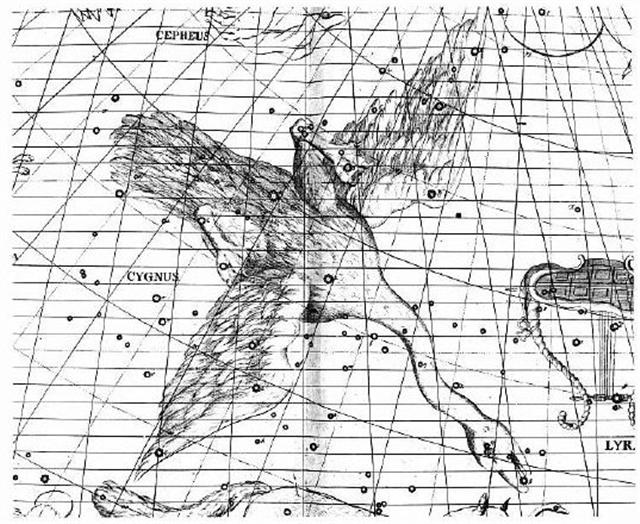 |
|
THE SUN: |
|
March 18 |
19 |
20 (261 - 182 = 79) |
21 (80) |
|
...
Ecclesiastically, the
equinox is reckoned to be on
21 March (even though the
equinox occurs,
astronomically speaking, on
20 March in most years)
...
 |
|
DZANEB (→ Deneb, Tail) = ω Piscium (362.4),
γ² Oct. (362.8)
*362.4 - *41.4 = *321.0 |
η Tucanae (363.0), ψ Pegasi (363.1),
32 Piscium
(363.2),
π Phoenicis (363.4),
ε Tucanae (363.6), τ
Phoenicis (363.9)
*322.0 = *363.4 - *41.4 |
θ Oct. (364.4)
*323.0 = *364.4 - *41.4 |
Al Fargh al Thāni-25 (Rear
Spout)
0h (365.25)
CAPH (Hand) =
β
Cassiopeiae,
SIRRAH (Navel of the Horse)
= α Andromedae
(0.5),
ε
Phoenicis,
γ³
Oct.
(0.8)
|
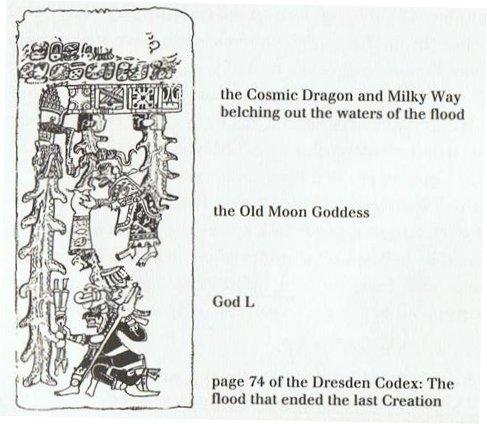
 |
 |
 |
|
Eb5-18 |
Eb5-19 (168) |
Eb5-20 |
|
te
tagata - e vai |
mama mamae
hia |
te henua -
Te kiore |
|
Mamae. Illness,
pain, to be ill or in
pain, afflicted;
tagata mamae,
the sick. Vanaga. Sick,
suffering, weak, ill;
mate maia mamae, to
depress; mata mamae,
drowsy, sleepy; mamae
kopu, bellyache;
mamae keo, headache;
mamae toto,
menses; ariga mamae,
to look ill;
hakamamae, to make
ill. T Mgv.: mamae,
to be ill, in pain,
suffering, sorrow. Mq.:
mamae, memae,
suffering, pain, grief.
Ta.: mamae, pain.
Churchill.
Kiore. Rat.
Vanaga. Rat, mouse;
kiore hiva, rabbit.
P Pau., Mgv.: kiore,
rat, mouse. Mq.: kioē,
íoé,
id. Ta.: iore,
id. Churchill.
 |
|
ALCHITA =
α
Corvi, MA WEI (Tail of
the Horse) =
δ
Centauri
(183.1),
MINKAR =
ε
Corvi
(183.7),
ρ
Centauri (183.9) |
PÁLIDA (Pale) =
δ
Crucis
(184.6),
MEGREZ (Root of the
Tail) =
δ
Ursae Majoris
(184.9) |
Hasta-13 (Hand)
/
Chariot-28 (Worm)
GIENAH (Wing) =
γ
Corvi
(185.1),
ε
Muscae (185.2),
ζ
Crucis (185.4), ZANIAH
(Corner) =
η
Virginis
(185.9)
*144.0 = *185.4 - *41.4 |
 |
|
Sept 20 |
21 (364 - 100 = 180 +
184 = 260 + 4) |
Equinox (265) |
|
"Aug 10 |
11 |
12 (224 = 265 - 41) |
|
JULY 18 |
19 (200) |
20 (224 - 23 = 201 = 265
- 64) |
|
...
The Corner of the House was
in the day before the
Creation of Our Present World -
which evidently could have been recreated
in "August 13 (225). i.e. in the
year 70 * 41 - 1842 AD = 1028 BC.
And this would then have been 23 * 70 =
1610 (→
JUNE 10) years after the preceding
similar such recreation in the Golden Age of
the Bull.
 |
|
THE SUN: |
|
March 22 |
23 |
24 (*3) |
|
Uttara Bhādrapadā-27
(2nd of the Blessed
Feet)
/
Wall-14 (Porcupine)
ο Oct. (1.3),
ALGENIB PEGASI = γ
Pegasi
(1.8) |
χ Pegasi (2.1), θ
Andromedae (2.7) |
σ Andromedae (3.0),
ι
Ceti (3.3), ζ Tucanae
(3.5), ρ Andromedae, π
Tucanae (3.7) |
 |
Beyond the September equinox the
normal Sun-oriented order
would evidently return, although the Sun ('the Rat')
would no longer be present in person,
this we can deduce from the open
perimeter of his figure:
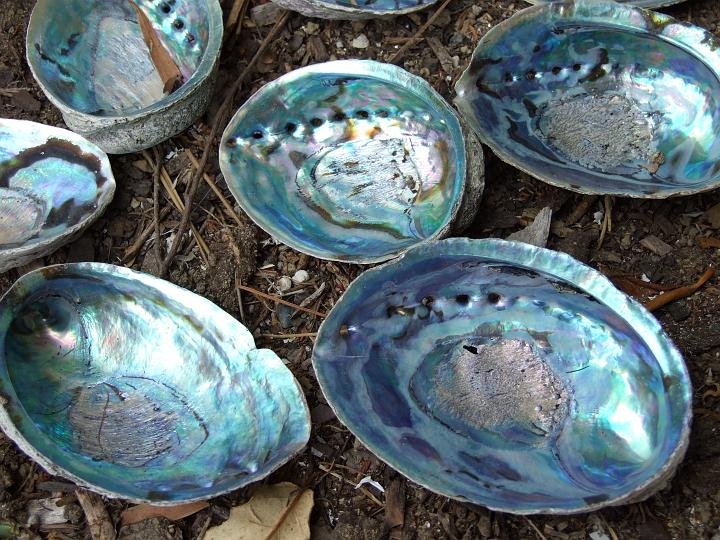
 |
 |
 |
 |
|
Eb5-21 |
Eb5-22 |
Eb5-23 |
Eb5-24 (173) |
|
ihe romi
hia |
e moa ure tupu
hia |
hetu
ki te ragi |
te
kiore - te henua |
|
THE SUN: |
|
Julian equinox (*4) |
March 26 (365 + 85 = 450) |
27 |
28 (*372) |
|
... When Julius Caesar
established his calendar in 45 BC he set March
25 as the spring equinox. Since a Julian year (365.25 days)
is slightly longer than an actual year the calendar drifted with
respect to the equinox, such that the equinox was occurring on about
21 March in
AD 300 and by AD 1500 it had reached 11 March. This drift induced
Pope Gregory XIII to create a modern Gregorian calendar. The Pope
wanted to restore the edicts concerning the date of Easter of the
Council of Nicaea of AD 325.
(Incidentally, the date of Easter itself is fixed by an
approximation of lunar cycles used in the Hebraic calendar, but
according to the historian Bede the English name 'Easter' comes from
a pagan celebration by the Germanic tribes of the vernal - spring -
equinox.) So the shift in the date of the equinox that occurred
between the 4th and the 16th centuries was annulled with the
Gregorian calendar, but nothing was done for the first four
centuries of the Julian calendar. The days of 29 February of the
years AD 100, AD 200, AD 300, and the day created by the irregular
application of leap years between the assassination of Caesar and
the decree of Augustus re-arranging the calendar in AD 8, remained
in effect. This moved the equinox four days earlier than in Caesar's
time ... |
|
No
star listed (4) |
ANKAA =
α
Phoenicis,
κ
Phoenicis (5.0)
ALPHARD (α
Hydrae |
λ Phoenicis (6.3),
β Tucanae (6.4)
*6.4 - *41.4 = *147.0 -
182.0 =
-
*35.0 |
ANDROMEDA GALAXY (M31),
π Andromedae (7.7) |
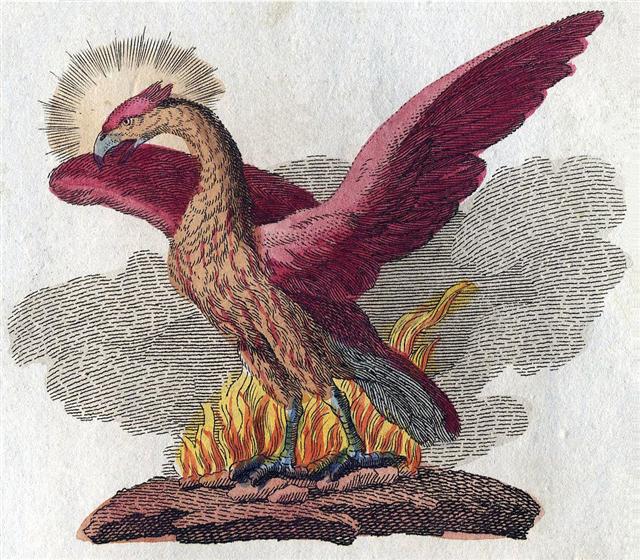
... Nut, whom the Greeks sometimes identified
with Rhea, was goddess of the sky, but it was debatable if in
historical times she was the object of a genuine cult. She was Geb's
twin sister and, it was said, married him secretly and against the
will of Ra. Angered, Ra had the couple brutally separated by Shu and
afterwards decreed that Nut could not bear a child in any given
month of any year. Thoth, Plutarch tells us, happily had pity on
her. Playing draughts with the Moon, he won in the course of several
games a seventy-second part of the Moon's light with which he
composed five new days. As these five
intercalated days did not belong to the official Egyptian calendar
of three hundred and sixty days, Nut was thus able to give birth
successively to five children: Osiris, Haroeris (Horus), Set, Isis
and Nepthys ... |
But on Easter Island it was the
place of the Full Moon which
mattered, and when the Sun
returned in spring north of the
equator it might be expected
that south of the equatorial
belt the
astronomers would find the Full
Moon together with some
prominent stars which
illustrated the opposite of
birth, namely death:
 |
 |
 |
 |
|
Eb5-21 (166 + 4) |
Eb5-22 |
Eb5-23 |
Eb5-24 (173) |
|
ihe romi
hia |
e moa ure tupu
hia |
hetu
ki te ragi |
te
kiore - te henua |
|
Hetu 1. To (make) sound; figuratively:
famous, renowned. 2. To crumble into embers (of a
bonfire). Hetu'u. Star, planet; hetu'u popohaga
morning star; hetu'u ahiahi evening star; hetu'u viri
meteorite. Vanaga. Hetu 1. Star (heetuu); hetu rere,
meteor; hetu pupura, planet. P Pau.: hetu, star. Mgv.:
etu, id. Mq.: fetu, hetu, id. Ta.: fetu,
fetia, id. The alternative form fetia in Tahiti, now
the only one in common use, need not be regarded as an anomaly in
mutation. It seems to derive from Paumotu fetika, a planet.
Its introduction into Tahiti is due to the fashion of accepting
Paumotu vocables which arose when the house of Pomare came
into power. 2. Capital letter (? he tu). 3. To amuse. 4. To
stamp the feet. Hetuhetu, to calk, to strike the water.
Hetuke, sea urchin. Churchill. |
|
VISIBLE CLOSE TO THE FULL MOON: |
|
Sept 23 (266) |
24 |
25 (*188) |
26 |
|
CHANG SHA (Long
Sand-bank)
=
ζ
Corvi
(186.3) |
INTROMETIDA (Inserted) =
ε
Crucis (187.4),
ACRUX = α
Crucis
(187.5)
*146.0 = *187.4 - *41.4 |
γ Com. Berenicis
(188.0),
σ
Centauri (188.1),
ALGORAB =
δ
Corvi
(188.5),
GACRUX =
γ
Crucis
(188.7) |
γ Muscae (189.0),
AVIS SATYRA (Bird of the Satyrs) =
η
Corvi
(189.3),
ASTERION (Starry) =
β
Canum Ven.
(189.5),
KRAZ
= β Corvi,
κ Draconis (189.7) |
|
... Whittier said, in his Cry
of a Lost Soul: 'The Cross of pardon lights the tropic
skies'; which is correct for our day, as it is not now entirely
visible above 27º 30' of north latitude. It was last seen on the
horizon of Jerusalem - 31º 46' 45'' - about the time that Christ was
crucified. But 3000 years previously all its stars were 7º above the
horizon of the savages along the shores of the Baltic Sea, in
latitude 52º 30' ... Von Humboldt adds:
The two great stars, which marks the summit and the foot of the
Cross, having nearly the same right ascension, it follows that the
constellation is almost perpendicular at the moment when it passes
the meridian. This circumstance is known to the people of every
nation situated beyond the Tropics or in the southern hemisphere. It
has been observed at what hour of the night, in different seasons,
the Cross is erect or inclined. It is a time piece, which advances
very regularly nearly four minutes a day, and no other group of
stars affords to the naked eye an observation of time so easily
made. How often have we heard our guides exclaim in the savannahs of
Venezuela and in the desert extending from Lima to Truxillo,
'Midnight is past, the Cross begins to bend' ... Crux lies in the
Milky Way, - here a brilliant but narrow stream three or four
degrees wide, - and is noticeable from its compression as well as
its form, being only 6º in extent from north to south, and less in
width, the upper star a clear orange in color, and the rest white;
the general effect being that of a badly made kite, rather than a
cross ...
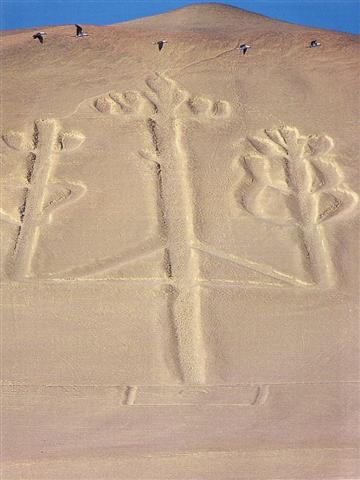 |
However, south of the equatorial
belt
the seasons of the Sun were
'upside down' and therefore instead of a final
place this was perceived as the place for a
new beginning, viz. that for
Mankind.

|














